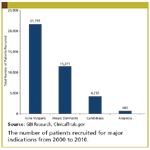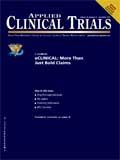Clinical Trial Recruitment in Dermatology
Applied Clinical Trials
Updates in dermatology trials.
Skin is the largest organ of the human body, and its complex and sensitive nature toward various foreign and internal factors makes it highly susceptible to a number of diseases and disorders.
The result of these foreign and internal factors (environmental, physical, microbial, hormonal, and others) is critical conditions and related symptoms.
Pharmaceutical companies conduct clinical trials based on factors such as a promising therapeutic area, unmet needs for a particular indication, and the presence of a significant patient population.

The number of patients recruited for major indications from 2000 to 2010.
Currently, there are many indications for which no appropriate treatment is available. Therefore, pharmaceutical companies are currently analyzing the potential of launching new therapies and tapping the potential market.
Research
An analysis of patients recruited for clinical trials which were "completed," "ongoing," and/or "started" during 2000–2010, showed that patient recruitment, among all the major indications under dermatology, was highest for acne vulgaris.
GBI Research discovered that the highest number of patients were recruited for clinical trials for acne vulgaris, atopic dermatitis, candidiasis alopecia, and herpes zoster—the figure depicts the results.
A study conducted on the number of patients recruited for clinical trials in dermatology shows that the total number of patients recruited for acne vulgaris clinical trials accounted for 48% of the total dermatology clinical trial recruitments, which accounted for a greater patient share than that of atopic dermatitis with 25%. The numbers of patients recruited for herpes zoster were 17%, followed by candidiasis with 9%, while alopecia clinical trial recruitment accounted for 1% of the total dermatology clinical recruitments.
R&D
In the dermatology sector, most companies coordinate their research and development (R&D) activities to constantly expand their product pipeline with innovative drugs.
Although there is a consistent and continuous threat from generics and other alternatives, companies in the dermatology therapy area are not reluctant to invest in R&D and are focused on offering new products to the market.
In addition to the threat from generics, patient recruitment is another major challenge for clinical research organizations. Patient recruitment is the most time-consuming process involved in clinical trials. Recruitment of patients is more difficult than treating them.
Recruitment
High competition is observed among the companies recruiting subjects with similar dermatological conditions. However, to achieve better results and easy determination of drug efficacy, the selection of subjects should be based upon the variability in dermatological symptoms/specification of the disease in patients.
This can be achieved by following physician referral, advertisements, and by conducting patient awareness programs through seminars and other means.
Adequate patient recruitment is necessary to ensure a successful trial within the scheduled time limit. Patient recruitment and enrollment within the proposed time limit enables the company to launch new products ahead of its competitors and maximize revenues from them.
Following the ethical guidelines established by the relevant regulatory authorities is one of the more important requirements in avoiding external barriers to the progress of trials.
— Syed Faiyaz Razvi is a Clinical Trials Analyst at GBI Research

Improving Relationships and Diversifying the Site Selection Process
April 17th 2025In this episode of the Applied Clinical Trials Podcast, Liz Beatty, co-founder and chief strategy officer, Inato, discusses a number of topics around site engagement including community-based sites, the role of technology in improving site/sponsor relationships, how increased operational costs are impacting the industry, and more.
Behind the Buzz: Why Clinical Research Leaders Flock to SCOPE Summit
February 7th 2025In this episode, we meet with Micah Lieberman, Executive Conference Director for SCOPE Summit (Summit for Clinical Ops Executives) at Cambridge Innovation Institute. We will dive deep into the critical role of collaboration within the clinical research ecosystem. How do we bring together diverse stakeholders—sponsors, CROs, clinical trial tech innovators, suppliers, patients, sites, advocacy organizations, investors, and non-profits—to share best practices in trial design, program planning, innovation, and clinical operations? We’ll explore why it’s vital for thought leaders to step beyond their own organizations and learn from others, exchanging ideas that drive advancements in clinical research. Additionally, we’ll discuss the pivotal role of scientific conferences like SCOPE Summit in fostering these essential connections and collaborations, helping shape the future of clinical trials. Join us as we uncover how collective wisdom and cross-industry partnerships are transforming the landscape of clinical research.